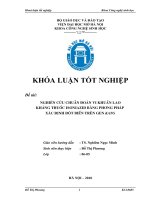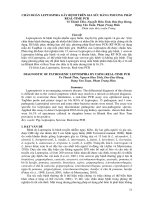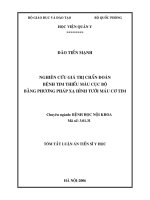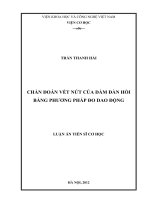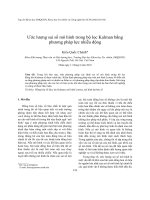Chẩn đoán vết nứt trong cần trục tháp bằng phương pháp thử nghiệm động TA
Bạn đang xem bản rút gọn của tài liệu. Xem và tải ngay bản đầy đủ của tài liệu tại đây (2.58 MB, 132 trang )
VIETNAM ACADEMY OF
MINISTRY OF EDUCATION AND
TRAINING
SCIENCE AND TECHNOLOGY
GRADUATE UNIVERSITY OF SCIENCE AND TECHNOLOGY
-----------------------------
LÊ TUẤN ANH
STUDY ON PARAMETRIZATION OF PHOTOFISSION
CROSS-SECTION OF
238
U AND OPTIMIZATION
SIMULATION USING GEANT4 FOR DESIGN OF THE
IGISOL FACILITY AT ELI-NP PROJECT
PhD THESIS IN ATOMIC AND NUCLEAR PHYSICS
Hanoi – 2021
MINISTRY OF EDUCATION AND
TRAINING
VIETNAM ACADEMY OF
SCIENCE AND TECHNOLOGY
GRADUATE UNIVERSITY OF SCIENCE AND TECHNOLOGY
-----------------------------
LÊ TUẤN ANH
STUDY ON PARAMETRIZATION OF PHOTOFISSION
CROSS-SECTION OF
238
U AND OPTIMIZATION
SIMULATION USING GEANT4 FOR DESIGN OF THE
IGISOL FACILITY AT ELI-NP PROJECT
Major: Atomic and Nuclear physics
Code: 9440106
PhD THESIS IN ATOMIC AND NUCLEAR PHYSICS
SUPERVISORS:
1. Dr, PHAN VIET CUONG
2. Prof, DIMITER L. BALABANSKI
Hanoi – 2021
LI CAM
OAN
Tổi xin cam oan Ơy l cổng trnh nghiản cøu m phƒn chı y‚u do tæi
trüc ti‚p thüc hi»n, phƒn cỈn l⁄i câ sü tham gia hØ trỉ cıa cĂc ỗng nghiằp ti
nhõm RA4, thuc dỹ Ăn ELI-NP ti Romania. CĂc kt quÊ nghiản cứu l trung
thỹc v chữa tng ữổc sò dửng trong bĐt ký cổng trnh n o kh¡c. Lu“n ¡n
cơng sß dưng mºt sŁ thỉng tin, s liằu thỹc nghiằm t nhiãu nguỗn s liằu
khĂc nhau v chúng ãu ữổc trch dÔn rê nguỗn gc.
TĂc giÊ
NCS. Lả TuĐn Anh
i
Acknowledgements
First and foremost, I gratefully express my best thanks to my supervisors,
Dr. Phan Viet Cuong at Research and Development Center for Radiation
Technology and Prof. Dimiter L. Balabanski at ELI-NP Romania for giving me an
opportunity to join ELI-NP project, to work in an international researching
environments, and for their limitless support and help me when I was in need.
I would like to thank Dr. Paul Constantin in RA4-ELI-NP group, who was
alway ready to spend his treasure time to help me through when I got problem not
in this work but also daily life in Romania. And I am also grateful to Dr. Bo Mei, Dr.
Deepika Choudhury, and all the members of RA4, as well as ELI-NP, who help me
a lot when I was at Romania.
I would like to thank the Board of Directors and all members of Graduate
University of Science and Technology for helping me during the process of doing
my thesis.
I also would like to thank my colleagues and friends in the VNU University of
Science, in Centre of Nuclear Physics, Institute of Physics, and in Vietnam Atomic
Energy Institute for their friendships and encouragements.
I would like to express my special thank to all my colleagues at Research
and Development Center for always giving me convenience to nish my work.
I would like to thank to all my colleagues at Institute for Nuclear Science and
Technology for their unlimited supports.
I would like to give my deep gratitude to my parents, my grandma, brother
and other members in my big family for their encouragements at all time.
And aftermost, I would like to express the most special thank to my wife
who has been always beside me, taken care of my two angel babies, to my
beloved children who are the motivation of my working.
ii
This work was supported by Extreme Light Infrastructure Nuclear Physics
(ELI-NP) Phase II, a project co- nanced by the Romanian Government and the
European Union through the European Regional Development Fund -the
Competitiveness Oper-ational Program (1/07.07.2016, COP, ID 1334).
iii
Acknowledgements . . . . . . . . . . . . . . . . . . . . . . . . . . . . . . . .
Abbreviations . . . . . . . . . . . . . . . . . . . . . . . . . . . . . . . . . . .
List of tables . . . . . . . . . . . . . . . . . . . . . . . . . . . . . . . . . . .
List of gures . . . . . . . . . . . . . . . . . . . . . . . . . . . . . . . . . . .
Abstract
Introduction
1 OVERVIEW
1.1
The Extreme Light Infrastructure Nucle
1.1.1
1.2
Methods for production of RIB . . . . . .
1.2.1
1.2.2
1.2.3
1.2.4
1.3
The future ELI-NP IGISOL . . . . . . . . .
1.4
Introduction of Geant4 toolkit . . . . . . .
1.4.1
1.4.2
1.4.3
1.4.4
1.5
Photo ssion process . . . . . . . . . . . . .
1.6
Purposes of the Thesis . . . . . . . . . . .
2 STUDY ON PARAMETRIZATION OF PHOTOFISSION CROSSSECTION OF
238
U
2.1
Empirical parametrization for total cros
charge distribution of
238
U photo ssion
2.1.1
2.1.2
2.1.3
2.2
Validation of the empirical parametriza
2.3
Prediction of neutron-rich nuclei yield .
2.4
Chapter conclusion . . . . . . . . . . . . . . .
3 OPTIMIZING THE DESIGN OF CRYOGENIC STOPPING CELL
FOR IGISOL FACILITY AT ELI-NP
3.1
The structure of the implemented Gea
3.2
Implementation of photo ssion process
3.3
Ionic e ective charge . . . . . . . . . . . . .
3.4
Target geometry optimization . . . . . .
3.4.1
3.4.2
3.4.3
3.4.4
3.4.5
3.4.6
3.5 The stopping length of photo ssion fragments in Helium gas. Guidance
for choosing the width of CSC . . . . . .
3.5.1
3.5.2
3.6
The extraction of photo ssion fragmen
3.7
Chapter conclusion . . . . . . . . . . . . . . .
Conclusion
Bibliography
Publications
Appendix
vi
Abbreviations
ELI
Extreme Light Infrastructure
ELI-NP
Extreme Light Infrastructure-Nuclear Physics
RIB
Radioactive Ion Beam
ISOL
Isotope Separation On-line
IGISOL Ion Guide Isotope Separation On-line
CSC
Cryogenic Stopping Cell
LIP
Low energy Interaction Point
HIP
High energy Interaction Point
DC
Direct Current
RF
Radio Frequency
HPLS
High-Power Laser System
PW
Peta-Watt
CBS
Compton Backscattering
GBS
Gamma Beam System
NRF
Nuclear Resonance Fluorescence
SM
Symmetric Mode
ASM
Asymmetric Mode
KE
Kinetic energy
PS
Potential Energy Surface
GDR
Giant Dipole Resonance
GSI
The GSI Helmholtz Centre for Heavy Ion Research
vii
List of Tables
2.1 The values of constants used in the empirical parametrizatio
photo ssion total cross-section. . . . . . . . . . . . . . . . . . . . . .
2.2 The values of constants used in the empirical parametrizatio
photo ssion mass yield. . . . . . . . . . . . . . . . . . . . . . . . . . . .
2.3 The values of constants used in the empirical parametrizatio
photo ssion isobaric charge. . . . . . . . . . . . . . . . . . . . . . . . .
3.1 Results for target geometry . . . . . . . . . . . . . . . . . . . . . . . .
3.2 Gas density dependence of various parameters . . . . . . . . .
viii
List of Figures
1.1
Sketch of the ELI-NP machines and experimental areas
1.2
Geometry of the inverse Compton scattering of a laser
relativistic electron. . . . . . . . . . . . . . . . . . . . . . . . . . . . .
1.3
Energy-angle correlation for two gamma beams . . . . .
1.4
The energy spectra of two gamma beams . . . . . . . . . .
1.5
Scheme of ISOL and In-Flight techniques [13, 14]. . . . .
1.6
Boiling and melting point of elements . . . . . . . . . . . . . .
1.7
The principle of IGISOL method [15] . . . . . . . . . . . . . . .
1.8
Gamma source schemetic layout . . . . . . . . . . . . . . . . .
1.9
Main components of the IGISOL beamline at ELI-NP . .
1.10
Layout of the IGISOL facility in the ELI-NP laboratory b
1.11
The Top Level Category Diagram of the Geant4 toolkit
1.12
The experimental photo ssion cross sections of
2.1
The
2.2
Measured mass yields for
2.3
The most probable charge Zprob . . . . . . . . . . . . . . . . .
238
U.
238
U photo ssion cross sections . . . . . . . . . . . . . .
238
U photo ssion . . . . . . . .
Comparison of the elemental yields Y (Z) =
2.4
2.5
238
U photo ssion experiments . . . . . . .
Comparison between the mass yields measured in two ex
ix
2.6 Ratio of independent yields of
2.7 Ratio of independent yields of
238
238
U photo ssion fragments
U photo ssion fragments
2.8 Comparison of the isotopic yields . . . . . . . . . . . . . . . . . . . .
2.9 Cross sections of fragments produced by photo ssion calcu
developed parametrization . . . . . . . . . . . . . . . . . . . . . . . . .
3.1 The structure of the implemented Geant4 code. . . . . . . . .
3.2 Kinetic energy versus atomic mass A of photo ssion fragmen
with our implementation. . . . . . . . . . . . . . . . . . . . . . . . . . .
3.3 Kinetic energy versus emitted angle of photo ssion fragmen
with our implementation. . . . . . . . . . . . . . . . . . . . . . . . . . .
3.4 Gamma beam transversal distribution . . . . . . . . . . . . . . . . .
3.5 View of the yz-plane of the target geometry inside the gas c
3.6 The dependence on the
238
U foil thickness t of the photo ss
3.7 The dependence of PB on the backing foil thickness-B. . .
3.8 Dependence of the fragment release rate N r on the beam threshold
energy. . . . . . . . . . . . . . . . . . . . . . . . . . . . . . . . . . . . . 61
3.9 The (Z,A) distributions of
ssion fragment at the time created inside foils 63
3.10 The (Z,A) distribution of release fragments . . . . . . . . . . . . . . . .
65
3.11 Kinetic energy KE distribution of photo ssion fragments . . . . . . . .
66
3.12 Stopping length L of the released photo ssion fragments in He gas at
3
0.206 mg/cm density. . . . . . . . . . . . . . . . . . . . . . . . . . . .
3.13 Stopping length for various densities of the He gas . . . . . . . . . . . .
3.14 Vertices of ionization processes . . . . . . . . . . . . . . . . . . . . . . . 70 x
67
69
3.15 Schematic drawing of the gas cell for the proposed IGISOL facility at ELINP ................................... 71
xi
ABSTRACT
The main focus of the thesis will be the optimization simulation using Geant4
for the design of a Cryogenic Stopping Cell (CSC) for a future IGISOL (Ion guild Isotope separation On-line) facility at ELI-NP (the Extreme Light Infrastructure: Nuc-lear
Physics). This proposed IGISOL facility will be dedicated to the study of exotic
neutron-rich nuclei produced via photo ssion of U
238
target inside CSC. A new reli-
able empirical parametrization for total cross-section, mass yield, and isobaric charge
distribution was developed in this study. A Geant4-based code was implemented for
the simulation of the photo ssion as well as the stopping of ssion fragments inside the
target foils and Helium gas. The simulation results have established the optimization
of CSC’s parameters, as well as those of the target con guration inside.
1
2
INTRODUCTION
The Extreme Light Infrastructure (ELI), which is marked on the European
Strategy Forum on Research Infrastructures (ESFRI) Roadmap as one of the
prior-ity research infrastructure projects for Europe, will be the world’s rst
international laser research infrastructure, pursuing unique science and research
applications for international users. ELI has three main research center located in
three di erent coun-tries: ELI-Beamlines facility in the Czech, the ELI-ALPS facility
in Hungary, and ELI-Nuclear Physics (ELI-NP) in Romania [1, 2, 3, 4].
ELI-NP is expected to be the most advanced research facility in the world in the
eld of photonuclear physics, and a new interdisciplinary research eld that brings
together, for the rst time, high-power lasers and nuclear physics. ELI-NP will o er a
highly-polarized tunable mono-energetic beam in the range from 200 keV to 19.5 MeV.
This kind of beam will open new possibilities for high-resolution spectroscopy at higher
nuclear excitation energies. This will lead to a better understanding of nuclear
structure at higher excitation energies with many doorway states, their damping widths
and chaotic behaviour, but also new uctuating properties in the time and energy
domain. Besides, the ELI-NP gamma beam is also suitable for the production of the
radioactive ion beam (RIB) through photo ssion of Uranium. The advance in the
understanding of nuclear structure far from stability using RIB is one of the top
priorities de ned by the nuclear physicist community in the world. To support this idea,
an IGISOL (Ion guide isotope separation on-line) facility will be constructed to extract
the photo ssion fragments to form RIBs at ELI-NP. The heart of the IGISOL is a
Cryogenic Stopping Cell (CSC), where the photo ssion process takes place. At ELINP, the development of a CSC is considered [2, 5].
For producing neutron-rich nuclei, designing nuclear physics experiments, as
well as a target system in CSC, an accurate calculation for production cross-section of
photo ssion fragments is crucial. Therefore, it is necessary to develop a reliable
3
tool for this job. This tool will be useful for estimating the yield of neutron-rich
nuclei from photo ssion process, designing nuclear physics experiments and many
other applications not only at ELI-NP but also at other photo ssion facilities
worldwide. Moreover, It is important to do series of prerequisite calculations and
simulations to lead to the conceptual design for the particular case of the CSC at
ELI-NP IGISOL facility.
The works in this thesis aim to ful ll two goals: i) the rst one is to develop a reliable
empirical parametrization for the calculation of photo ssion cross-section over a wide
energy range below 30MeV. ii) The second one is to implement a Geant4-based code and
carry out a series of simulations to optimize the design of CSC at ELI-NP.
This thesis is structured as follows. In Chapter 1, the introduction of ELI and
ELI-NP project is presented, as well as the photo ssion process, the methods for
the production of RIB, and Geant4 toolkit. Chapter 2 is dedicated to describing the
constructing process of the empirical parametrizations for total cross-section, mass
yield and Isobaric charge distribution of
238
U photo ssion. The works in Chapter 2
will ful ll the rst goal. Meanwhile, Chapter 3 is dedicated to present the
implementation of Geant4-based code and simulation results for optimizing the
design of CSC, which will ful ll the second goal. Finally, in the Conclusion part, a
summary of this work is given.
4
Chapter 1. OVERVIEW
1.1. The Extreme Light Infrastructure Nuclear Physics facility
The Extreme Light Infrastructure (ELI) is a Research Infrastructure of PanEuropean interest. ELI will be a multi-sited Research Infrastructure with complement-ary
facilities located in the Czech Republic, Hungary, and Romania for the investigation of
light-matter interactions at the highest intensities and shortest time scales [4].
ELI-NP facility in Romania, which is one of the three pillars of the ELI, will
develop a scienti c program using two beams of 10 PW laser and a Compton
back-scattering (CBS) high-brilliance and intense low-energy gamma beam [1, 2,
3]. The ELI- NP project consists of two main experimental areas: the ELI-NP HighPower Laser System (HPLS) and Gamma Beam System (GBS). Fig. 1.1
expresses the sketch of ELI-NP machines and experimental areas. The HPLS is
designed for the following study cases [1, 2, 3]:
The E1 Area host experiments of 2 10 PW laser with high density targets
for production of extremely high uxes of protons and high-Z ions, as well as
neutrons and their use in nuclear physics research and applications.
The E5 experimental area is dedicated for experiments of materials irradiation
with simultaneous, mixed types of nuclear radiation produced by two 1 PW/1
Hz laser beams.
The E6 experimental area will be dedicated to strong- eld quantum electrodynamics (QED) experiments.
Meanwhile, the study of photo ssion and the production of RIB are provided
by the Gamma Beam System, and discussed in the following subsections.
5
Figure 1.1: Sketch of the ELI-NP machines and experimental areas. HPLS High Power
Laser System; OPCPA: Optical Parametric Chirped Pulse Ampli cation; XPW: Cross
Polarised Wave system; LBTS: Laser Beam Transport System; GBS Gamma Beam
System; DPSSL: Diode Pumped Solid State Laser; E1-E8 Experimental areas. [3]
1.1.1. Gamma Beam System
A highly-polarized ( 95%) tunable mono-energetic beams of spectral density
4
of 10 photons=(s:eV ) in the range from 200 keV to 19.5 MeV with a bandwidth of
0:3% [3, 2, 5, 6] will be produced by ELI-NP GBS. These beams will be produced
through laser Compton backscattering (CBS) o an accelerated electron beam delivered
by a linear accelerator. The Compton backscattering (also called inverse Compton
scattering) is considered as "photon accelerator". Fig. 1.2 shows the geometry of the
CBS between a laser photon E L energy, incident at angle L respect to the electron
beam direction, and a relativistic electron with energy E e. The energy of out-going
6
Figure 1.2: Geometry of the inverse Compton scattering of a laser photon on a
relativ-istic electron.
gamma scattered at an angle is given by
E( )=2 e
p
2
where e = 1 (ve=c) is the Lorentz factor for electron, ve is the electron velocity, me
is the rest mass of the electron, and c is the speed of light.
Eq.(1.1) implies that by using a suitable collimator placed at certain angle,
one can select the energy of gamma beam.
As shown in Fig. 1.1, the ELI-NP gamma beam uses a green laser 0.4 J
pulse energy with the wavelength = 515nm, corresponding to an incident photon
energy EL = 2:4 eV. The maximum energy, which a scattered photon can gain is
achieved in head-on collisions, L = 0. In case of ELI-NP gamma beam, with a
given Ee, the maximum energy of gamma is [6]:
E
max
(Ee) = 9:55eV (1 +
Fig. 1.3 presents two types of beams that will be delivered at ELI-NP. The broad
gamma beam displayed with blue dots has the energy range 10 18:5 MeV. It was obtained
by using Ee = 720M eV and collimating the beam below 0.7 mrad with a lead collimator.
The red dots in Fig. 1.3 presents the pencil beam with the narrow energy range around
12.9 MeV. The pencil beam was obtained by setting Ee = 600M eV and collimating the
beam below 0.09 mrad. The energy spectra of these two beam types are
7
Figure 1.3: The simulated results for energy-angle correlation for two gamma
beams: a broad beam up to 18.5 MeV collimated below 0.7 mrad (blue) and a
pencil beam up to 12.9 MeV collimated below 0.09 mrad (red). The pencil beam is
enclosed in a dashed red box for visibility. [6]
shown in Fig. 1.4. The spectrum of broad gamma beam covers most of the Giant Dipole
Resonance region of Uranium and Thorium [7], making it suitable for the production of
exotic neutron-rich nuclei by photo ssion. Meanwhile, the narrow beam-type will be
suitable for experiments that demand a quasi-monochromatic gamma beam.
Bases on such kinds of gamma beams, ELI-NP GBS will provide the
following experiments [10, 3]:
NRF experiments: The Nuclear Resonance Fluorescence (NRF) technique is
an outstanding tool for the investigation of low-lying dipole excitations in atomic
nuclei and provides a speci c research niche for the ELI-NP facility. In experiments, the pencil gamma beams scattered o bound nuclear state will provide
access to targets that are available in small quantities and will open the actinide
8
Figure 1.4: The energy spectra of the broad beam between 10{18.5 MeV (blue
squares) and of the pencil beam at 12.9 MeV (red circles) from Fig. 1.3 [6]
.
region for NRF studies.
Photonuclear Reaction: The ELI-NP pencil beam makes it a precise tool for studies
the characteristics of photonuclear reactions, such as cross-section, Iso-
mer ratio, reaction yield.
Experiments above the Neutron Separation Threshold: The brilliant, narrowwidth, highly-polarized -ray beam will provide an opportunity to study the
nuclear photo-response at and above the particle separation threshold, such
as the pygmy dipole resonance (PDR) at and above the particle threshold,
which is essential for nucleosynthesis in astrophysics [2, 11, 3].
Nuclear Astrophysics Studies: The -induced nuclear reactions of
7
4
astrophysical, such as Li( ; t) He,
16
12
O( ; ) C . . .
9
Photo ssion experiments and the production of RIB: Because of having an
energy range that covers the whole Giant Dipole Resonant of Uranium and
Thorium isotopes [1, 2, 7], the ELI-NP gamma beam is suitable for the
produc-tion of the exotic neutron-rich isotopes in the Zr-Mo-Rh light
fragment region and in the rare-earth heavy fragment region. To support this
idea, an IGISOL facility will be constructed at ELI-NP. Some parts of the
works in this thesis will help to form the conceptual design for this future
IGISOL facility. In fact, three exist three methods for the production of RIB.
The reason for choosing IGISOL technique is discussed below.
1.2. Methods for production of RIB
To address which method is suitable for producing RIB at ELI-NP, the
details of each method will be discussed as following.
1.2.1. The ISOL technique
ISOL stands for Isotope Separation Online. In the ISOL technique, the radioactive ion beams are produced via light-ion-induced spallation or ssion of a thick actinide
target. The ssion reactions can be induced by thermal neutrons, fast neutrons, protons or photons. This method requires a high intensity of the primary beam and a thick
hot target. The great advantage of the thick targets is a large number of target atoms
available for the production of the ions. Even for such exotic nuclei with extremely low
production cross-sections can still be obtained. However, short-lived isotopes cannot
be obtained because of the time required for di usion and e usion [12, 13, 14]. Another disadvantage with ISOL production is that it is di cult to achieve high beam purity
due to the many isobars of di erent elements produced simultaneously in the target.
Furthermore, refractory elements are in general di cult to produce due to the high
temperatures required to make them volatile, see gure 1.6 [14].
The general scheme of a typical ISOL facility is shown in Fig. 1.5 . The
production of RIB by ISOL technique is summarized as follows: the primary beam
hits the target to induce the nuclear reactions, the residual nuclei is di used to the
10
Figure 1.5: Scheme of ISOL and In-Flight techniques [13, 14].
target surface by heating and, in the meantime is thermalized, neutralized due to
thick target. The reaction products then are re-ionized by ionization source and
separated by mass-separator.
The intensity of the RIB of interest depends on many factors, expressed as:
I = : :N:
:
:
:
target source separ det
where is the ux of the primary beam, is the reaction cross section, N is the number
of atoms in the target, target is the element release e ciency from the target, source
is the e ciency of the ion source, separ is the separation e ciency and det is the e
ciency of the detection system.
1.2.2. The in- ight method
The lower drawing in Fig. 1.5 expresses the scheme of In-Flight technique. In
this method, the fragmentation or ssion of intense heavy-ion beams in a thin target
made of light elements such as carbon and beryllium was used for the production of
RIB. The thin target allows the fragments to release from the target surface still at very
high velocity and forward momentum which is exploited for mass separation and study
or further reactions. An advantage of this method, which is opposite to ISOL
11
Figure 1.6: Boiling and melting point of elements
technique, is that the production of the RIBs is independent of the chemical
properties of the element. Moreover, isotopes with very short half-lives and even
isomers are available as RIBs. On the contrary, the optical properties of the RIBs
are poor due to the kinetic energy spread and their divergence that results from
the production process. Since the intensities of the heavy-ion beams are generally
lower than that of the light-ion beams used for the ISOL method, the yields of
some exotic fragments may also be somewhat lower [12].
1.2.3. Ion guide isotope separation online technique
Figure 1.7 illustrates the principle of IGISOL method based on the very begin-ning
design. The idea of this technique is that the nuclear reaction products which release from
+
the target into gas will be slowed down and thermalized in the gas cell to 1 charge state.
The bu er gas is typically helium, argon could be used in some special cases [13, 15]. In
some senses, the IGIGOL is similar to ISOL, except for the target part. Instead of using a
thick target, in this approach, one or several thin targets are
12
Figure 1.7: The principle of IGISOL method [15]
used. The release ions are swept by the gas ow out of the cell and injected
through a pumped electrode system into the isotope separator [14, 15].
The thickness of the target is limited to the range of the recoil ion in the target
to obtain the highest release e ciency. The range, for instance, is of the order of 1
2
2
mg/cm for fusion-evaporation residues and 15 mg/cm for ssion fragments [15].
1.2.4. Method for production of RIB at ELI-NP
At ELI-NP the RIB will be created through the photo ssion process, namely, the
incident particle will be gamma. Therefore, as mentioned in subsection 1.2.2, the Inight method is not suitable. The ISOL method seems to be usable for the incident
particle of gamma. However, at ELI-NP, the RIB will be dedicated to studying the
exotic neutron-rich isotopes in the Zr-Mo-Rh region which is the refractory elements.
As shown in Fig. 1.6, Zr-Mo-Rh region has a very high boiling and melting point.
Hence, they can not be di used to the target surface by heating. As a consequence,
the ISOL method is not the candidate for the production of RIB at ELI-NP.
Meanwhile, by using thin targets, the IGISOL method can be used for the
production of RIB in the refractory region. Therefore, at ELI-NP an IGISOL facility
